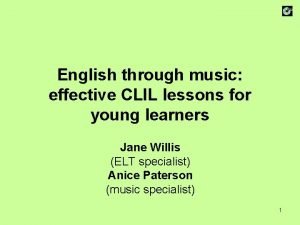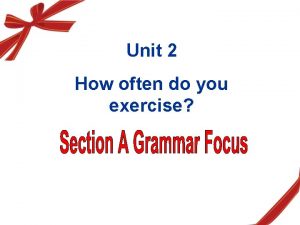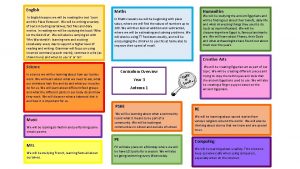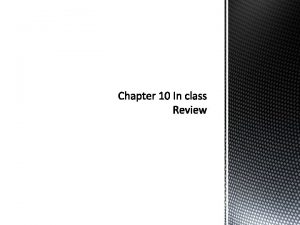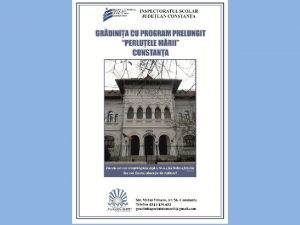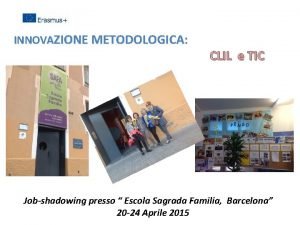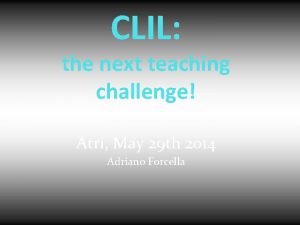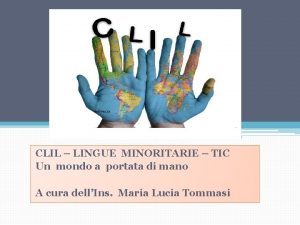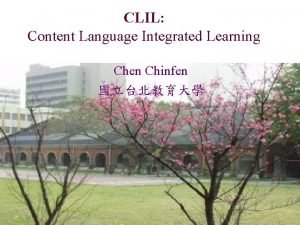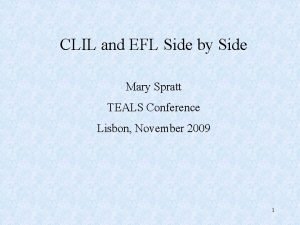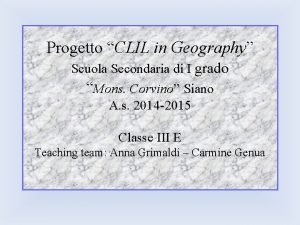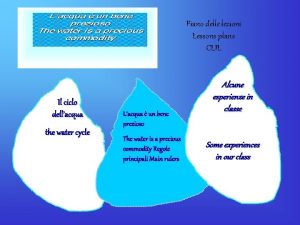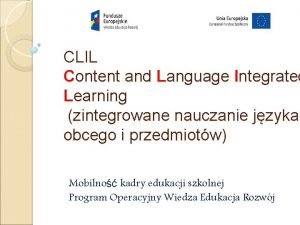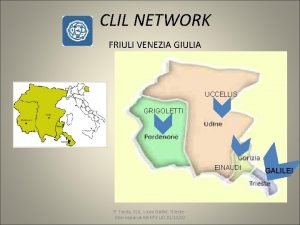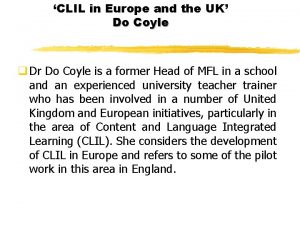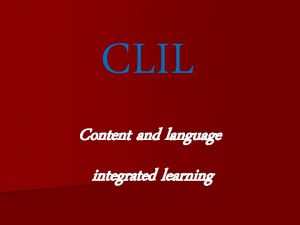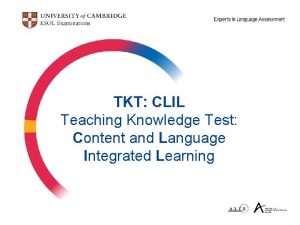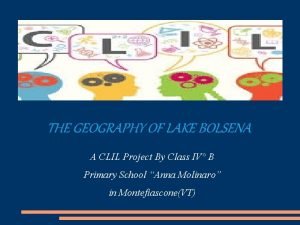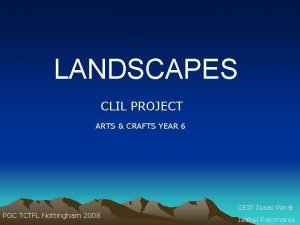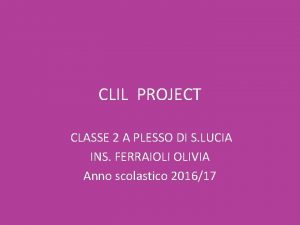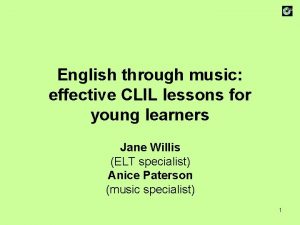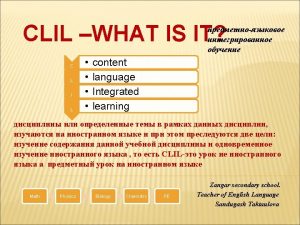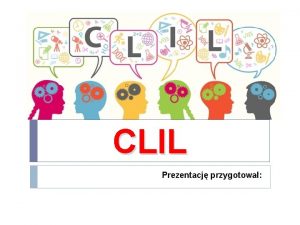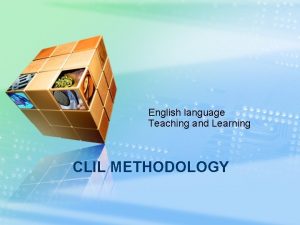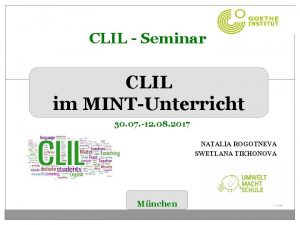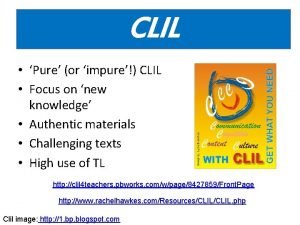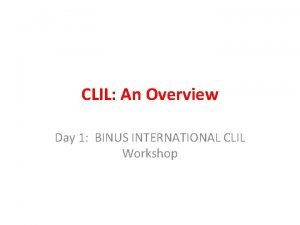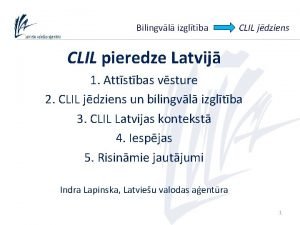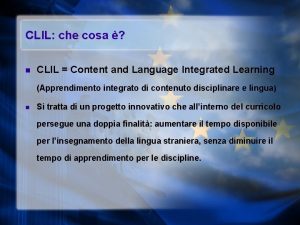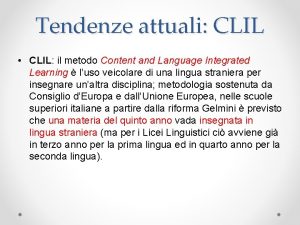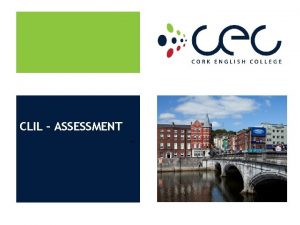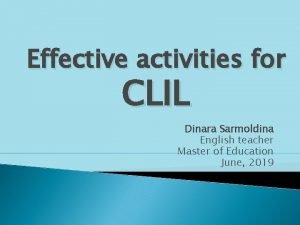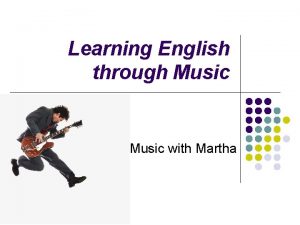English through music effective CLIL lessons for young



































- Slides: 35

English through music: effective CLIL lessons for young learners Jane Willis (ELT specialist) Anice Paterson (music specialist) 1

English through music: effective CLIL lessons for young learners Jane Willis (ELT specialist) Anice Paterson (music specialist) 2

OVERVIEW What potential does Content & Language Integrated Learning (CLIL) have for language development? Why is music particularly suited to CLIL? What kinds of musical activities are there? (with brief demonstrations of some of them) How can you ensure these music activities fulfil conditions that are likely to promote language learning? 3

Content & Language Integrated Learning (CLIL) Learning a subject through English provides young learners with: • exposure to spoken English • a clear purpose for listening to English and trying to understand • a context for using English • a reason for reading and writing 4

Music through English? or English through music? Why music and English together? 5

6

Singing is an excellent way for children to • learn and memorise words and phrases • develop familiarity with the sounds, rhythms and stress of English 7

Songs, rhymes and rhythm activities help children to • learn to listen carefully – with a real purpose • respond to the ranges in tone, pitch, and expression in the voice • concentrate hard on small details of pronunciation, stress and rhythm 8

Musical pictures and musical stories help children to • experiment and use the qualities of sounds effectively • express their feelings • recognise the structure of stories and poems and to sequence ideas • talk about what they are doing and why • tell and perform their own stories 9

Rehearsing and giving musical performances • provides children with a real purpose for developing and practising their English • helps children to develop self-confidence - in using English in a range of contexts - in performing with control and expressiveness • keeps children motivated and excited by their experience of making music Also, NFER has evidence of beneficial effects on general behaviour and learning skills 10

A giant 11

The giant story Recorded in a class of 9 year-olds who • have various soundmakers • listen to the story, bit by bit, and suggest sounds for each action • perform the whole story, with sounds • create variations CD 55 1. First of all, I want you to imagine that there’s a huge giant and he’s eating his dinner at his table. Can you make eating sounds? 2. And on the door there’s a tap tap… Can you repeat that rhythm for me? Keep it going – tap tap… 3. The giant stands up and slowly walks to the door 12

The enormous carrot Teacher with five-year-olds 13

So what are they learning? Musical skills Experimenting with sounds Creating sound patterns Remembering a sequence Performing a piece Creating variations Language development Exposure to story text & to teacher talk that engages attention (imperatives, repetitions, on-going commentary) Opportunities for participatory use of language 14

15

What kinds of music activities are there? These activities cover musical objectives that appear in any typical music syllabus. A Warm-up activities ‘Listen and Do’ – physical and vocal exercises to prepare children for music making and to develop their co-ordination, voice control, and pronunciation. 16

Physical warm-ups Some examples (all on CD) • ‘Stretch, shake and wiggle • ‘Pat your head and rub your tummy’ • Baby 1, 2, 3 17

Vocal warm-ups Breath control: snakes, bees, humming Musical vowels: sirens, scales Consonant patterns: slow - ping pong; fast - ch ch Voice expression: Boom chicka boom 18

B Listening and experimenting with sounds • Hands and feet CD 15 (Body Percussion) • Let’s make a band (Sound-makers) 19

20

Action songs & rhymes Section C (minimal language) • The Rocket Rhyme Count down, count down, rocket leaving soon Count down, count down, leaving for the moon 10, 9, 8, 7, 6, 5, 4, 3, 2, 1 Blast off! Section F (more language) • There’s a tiny caterpillar on a leaf 21

A Rhythm Grid Some very small creatures ‘OK, Let’s start with a steady beat…. . a very quiet beat. . Keep it going… Now listen 22

23

D Rhythm games & patterns Clap it back (fruit, vocabulary sets) Pop Spider Ant (small creatures, party food) Language and music aims: Syllable stress in words and phrases Performing layered patternings (in parts) 24

E Listening and responding to music • How long does it last? (instrument sounds) • I like it (different styles, images, moods, countries) CD 40 • Let’s dance Children hear about where the music is from, think what it could be about, express how the music makes them feel. . . 25

26

Composing and performing class music G Story-based music • Musical books (any story) • The giant • The enormous carrot (growing food and farm animals) H Musical pictures • Rainstorm (tropical climate) • Where shall we go today? (zoo, market…) 27

28

Activity Page • LANGUAGE • MUSIC • RESOURCES AND PREPARATION • TIME GUIDE AGE …………………… • Activity (numbered steps and suggestions for what to say in English). • Variations (ideas for other similar musical activities) • Language extensions 29

Language extensions Suggestions for building on the language used in the activity: • same music aims but new context or song • mini-dialogues for intonation work • games for vocabulary revision e. g. miming • tongue twisters • follow-up chats / discussions • mini-projects with cross-curricula links. 30

Questions 1. How does this fit my English syllabus? 2. Are the activities graded? 3. How to use the CD? 4. Musical expertise? Teacher support? 31

What language learning opportunities do these CLIL lessons provide? Four main sources 1. general classroom management and instructions 2. the language used to introduce the topic, to set up the music activity itself, to attain the music aims & lead to a musical performance 32

What language learning opportunities do these CLIL lessons provide? 3. the words and phonological features of the songs, rhymes, chants, stories, and mini-dialogues, 4. further development of specific language features and topic themes 33

And finally… the three most important things… • use the musical activity to generate opportunities to interact with the children in English • encourage children’s language and music development by being positive • make sure you all enjoy making music. 34

‘English Through Music’ Anice Paterson & Jane Willis OUP 2008 jane@willis-elt. co. uk 35
 Clil music lesson plan
Clil music lesson plan Online music portfolio
Online music portfolio Courage zone 7 habits
Courage zone 7 habits Matthew 19 lesson
Matthew 19 lesson How often do you usually do exercise
How often do you usually do exercise Maths in english lessons
Maths in english lessons Is rap music more popular among young
Is rap music more popular among young Esempio di lezione clil diritto
Esempio di lezione clil diritto Metoda clil componente
Metoda clil componente Tic e clil
Tic e clil Clil meaning
Clil meaning Clil matrix
Clil matrix Clil meaning
Clil meaning Tic e clil
Tic e clil Clil meaning
Clil meaning Language
Language Clil meaning
Clil meaning Clil metodi haqida
Clil metodi haqida Cele 4 componente ale metodei clil
Cele 4 componente ale metodei clil Clil geografia scuola media
Clil geografia scuola media Clil ciclo dell'acqua
Clil ciclo dell'acqua Clil przykłady
Clil przykłady Clil grigoletti
Clil grigoletti Do coyle clil
Do coyle clil Clil showers
Clil showers Tkt clil
Tkt clil Progetto clil
Progetto clil Metodologia clil
Metodologia clil Hard clil
Hard clil Many vile earthlings
Many vile earthlings Clil geography primary school
Clil geography primary school Tctfl
Tctfl Tarkoma
Tarkoma Clil water
Clil water Clil
Clil Clil topics
Clil topics
